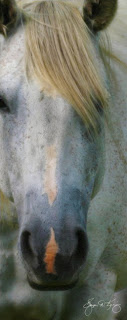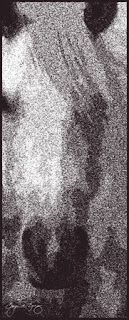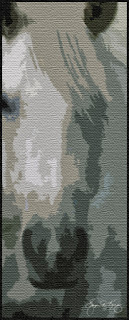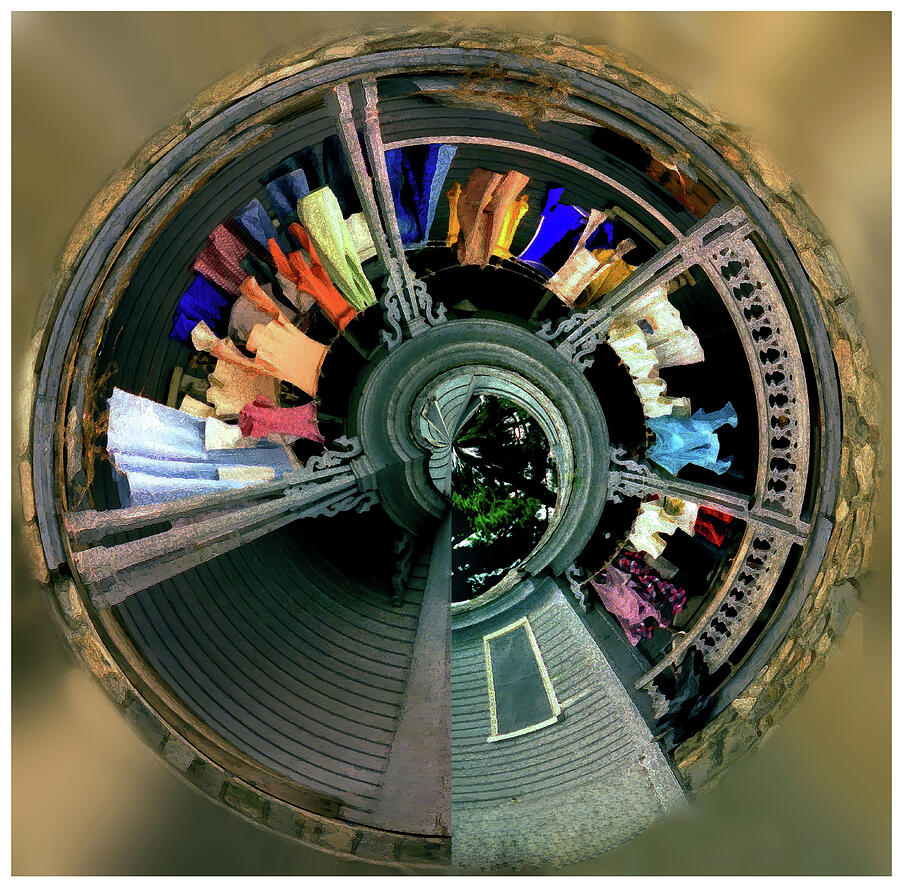I rarely use a single filter when creating a variation on a theme but combining filters provides both the challenge and the outcome that makes the creation of the art fulfilling and interesting.
 Recently I took an image of a beautiful old soul photographed along a country road in the town of Benton New Hampshire. In his heyday, this white horse was probably a showstopper. Looking at him now you can still see how he would have turned heads as a three year old or even at 6 or 7 but now, at what I estimated was approaching 30 the old fellow's best days were behind him. Yet here he stood, in a pasture he shared with scottish highlanders, sheep, other horses, even a few llamas, and the gentle wisdom of his soul shone in his eyes and his aura.
Recently I took an image of a beautiful old soul photographed along a country road in the town of Benton New Hampshire. In his heyday, this white horse was probably a showstopper. Looking at him now you can still see how he would have turned heads as a three year old or even at 6 or 7 but now, at what I estimated was approaching 30 the old fellow's best days were behind him. Yet here he stood, in a pasture he shared with scottish highlanders, sheep, other horses, even a few llamas, and the gentle wisdom of his soul shone in his eyes and his aura.I took one of the images I captured of the old fellow and spend several days trying to express my fascination with him through a series of variations on a theme.

After cropping the image to a point where the starting point was uniquely different from any other image I had created of this horse, I began by simply softening the focus.
The soft focus give the image an emotional appeal.
Removing the color and adding color back in gives you an opportunity to see the image as a monochromatic one and then to test various levels of color. The image to the right is actually a duochromatic image with a touch of brown added back in because it adds a bit of warmth. Next using a history brush filter I restored the mane at the top of the image and a touch of the pink in the horses muzzle.

This added color creates a surreal image with the combination of duochromatic base and some added color to just lightly color the image.
Paintbrush Filters
 Several of the software programs available, like Photoshop, offer various filters that mimic painting or drawing styles. Most of the time I feel as though such filters are an affectation, adding little and often detracting from the image. However, from time to time I will find that an image lends itself well toward one or another of the brush or draw filters. If there is a way to view the image in each of the filters - as there is with Photoshop - you can do a simple test checking how each appears with each filter treatment, permitting you to view the image with each style to see if there is one or more filter that catches your fancy. In the case of this image a drybrush filter gave me something that I thought I could work with so I made some modifications to the original image, muting the color in the muzzle eand the mane before applying the filter giving me a color image that appeared more "painterly". I often find that the watercolor filter does some interesting things as well, although with this image watercolor did not see to work.
Several of the software programs available, like Photoshop, offer various filters that mimic painting or drawing styles. Most of the time I feel as though such filters are an affectation, adding little and often detracting from the image. However, from time to time I will find that an image lends itself well toward one or another of the brush or draw filters. If there is a way to view the image in each of the filters - as there is with Photoshop - you can do a simple test checking how each appears with each filter treatment, permitting you to view the image with each style to see if there is one or more filter that catches your fancy. In the case of this image a drybrush filter gave me something that I thought I could work with so I made some modifications to the original image, muting the color in the muzzle eand the mane before applying the filter giving me a color image that appeared more "painterly". I often find that the watercolor filter does some interesting things as well, although with this image watercolor did not see to work. Finally, as a test for developing an image that could be applied to a tapestry I chose a filter that would give the image a sort of burlap look. When applied to a cloth this image would yield an interesting effect as a commercial product. As you can see, the image would not appeal to someone as a photographic print but on a pillow or tapestry it would create a nice effect.
Finally, as a test for developing an image that could be applied to a tapestry I chose a filter that would give the image a sort of burlap look. When applied to a cloth this image would yield an interesting effect as a commercial product. As you can see, the image would not appeal to someone as a photographic print but on a pillow or tapestry it would create a nice effect.This entire process uses only one image to produce the various "studies" or treatments but sometimes combining more than one image can also create interesting effects.
In the next entry we will combine two images that take the image from a sweet photograph to a whimsical powerhouse.



No comments:
Post a Comment